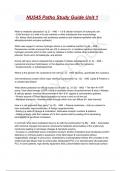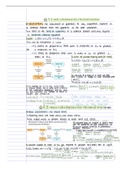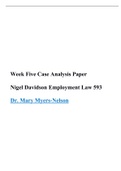NU545 Patho Study Guide Unit 1
What is metabolic absorption? (p.2) - ANS • 1 of 8 cellular functions of eukaryotic cell
• Chief function is to take in & use nutrients or other substances from surroundings
• Ex: kidney (fluid absorption and synthesize proteins) and Intestinal epithelial cells (fluid
absorption/protein enzyme synthesis)
K
What uses oxygen to remove hydrogen atoms in an oxidative reaction? (p.8) - ANS •
Peroxisomes contain enzymes that use O2 to remove H+ in oxidative reactions that produces
hydrogen peroxide which is then used by catalase to further oxidize other substances like:
C
phenols, formic acid, formaldehyde, and alcohol
During cell injury what is released that is capable of cellular autodigestion? (p. 8) - ANS •
LO
Lysosomal enzymes (hydrolases), or the digestive enzymes within the lysosome
• Autolysosomes, or autophagosomes
Where is the genetic info contained in the cell? (p. 2) - ANS Nucleus, specifically the nucleolus
YC
Cell membranes contain which major chemical components? (p. 12) - ANS Lipids & Proteins in
a complex lipid bilayer
What allows potassium to diffuse in and out of cells? (p. 31-32) - ANS • The Na+-K+-ATP
pump. Uses direct energy of ATP; found in excitable tissues (muscles/nerves) & also in kidneys
& salivary glands. Involves the movement of Na+ & K+ against a concentration gradient.
D
• Protein enzyme ATPase allows potassium to move in and out of the cell.
• Mediated transport = channel protein through which ions can diffuse (K+ leak channel).
U
How is a cell protected from injury? (p.12) - ANS • Plasma membrane - Acts as a barrier to
toxic molecules, macromolecules, & foreign organisms/cells.
• Exists in a state of change & modulation. Alternates receptor numbers & patterns.
ST
• Gating protects cells from release of Ca from injured cells by sealing off or decreasing
permeability at junctional complexes.
In cirrhosis, what does cholesterol have to do with the erythrocytes? (p.68) - ANS • Associated
with chemical changes that result in structural & metabolic abnormalities of the erythrocyte
membrane leading to cell shape changes & hemolytic anemia.
• Increase in unesterified serum cholesterol owing to lecithin cholesterol acyl transferase (LCAT)
deficiency in cirrhosis leads to expansion of the lipid bilayer & macrocytosis without
megaloblastic changes in precursors. Substitutions of phosphatidyl choline (PC) moieties in the
erythrocyte lipid bilayer lead to echinocytes (disaturated PC) or to stomatocytes (diunsaturated
PC). In some patients, high density lipoprotein (HDL) abnormalities lead to erythrocyte surface
,changes causing rapid formation of echinocytes. (Ann Clin Lab Sci. 1990
May-Jun;20(3):169-74.Mechanisms of hemolysis in liver disease.Morse EE1.
Department of Laboratory Medicine, University of Connecticut School of Medicine, Farmington
06032)
• Alters fluidity & function of cell membrane as well as intercellular transport
What is platelet-derived growth factor? (p.39) - ANS Stimulates production of connective tissue
cells & neuroglial cells
What is cell communication? How does it occur? (p.20) - ANS • Required for homeostasis,
K
regulate cellular growth/division & development/organization into tissues, & coordinate cellular
function.
• Occurs in 3 ways:
C
-via protein channels & gap junctions that directly coordinate activities of adjacent cells (must
be touching)
-via plasma membrane-based signaling molecules (receptors) that affect the cell itself & cells
LO
that come in direct contact
-via chemical signals that must enter the distant cells to affect the receptors inside of the distant
cell (the most common means of communication).
• Primary modes of intercellular signaling are hormonal, neurohormonal, paracrine,
contact-dependent, & neurotransmitters. There is also Autocrine signaling where the cell signals
YC
itself.
What is chemical signaling? (p.20) - ANS Involves the secretion of chemicals, such as
hormones, neurohormones, paracrine, autocrine, and neurotransmitters. Chemical signaling
may occur through the bloodstream or in small discrete spaces
D
How is glucose transported from the blood to the cell? (p. 33) - ANS Passive protein channels.
Passive mediated transport or facilitated diffusion moves the glucose via a uniport mechanism
into the cell. When all glucose-specific receptors are occupied, the transport system is saturated
U
and operating at maximal capacity. Direction of movement is the same as passive simple
diffusion-down the concentration gradient, from an area of high concentration to low
concentration until equilibrium is achieved.
ST
Understand the transportation of potassium and sodium across plasma membranes. (p. 29-32) -
ANS • The Na+ K+ antiport (opposite directions) system uses direct energy of ATP to move
cations.
• ATPase is transporter protein.
• Concentration of ATPase in plasma membranes is directly related to Na+ K+ transport activity.
• Process:
- 3 Na+ ions bind to Na-binding sites on carrier's inner face.
- ATP molecule produced by cell's mitochondria binds to carrier.
- Carrier changes shape, releases 3 Na+ ions to outside of cell, & attracts 2 K+ ions to
K-binding sites.
, - Carrier returns to original shape, releasing 2 K+ ions & the leftover ATP molecule to inside of
cell.
- Carrier can now repeat cycle.
What is active transport? (p. 31-33) ch.1 - ANS • The movement of a substance across a
membrane by a carrier protein. Requires metabolic energy (ATP) to move the molecules against
the concentration gradient.
• Active transport also occurs by endocytosis (vesicle formation), where substances are
engulfed by a segment of the plasma membrane, forming a vesicle that moves into the cell.
K
What are cytokines? (p.38-39)
Or cytokinesis? (p.37) - ANS • Cytokines are peptides that transmit signals within/between
cells to stimulate tissue growth & development.
C
Do all cells continue to replicate or divide? (p. 39) - ANS • No, all types of cells undergo mitosis
during formation of the embryo, but adult cells including: nerve cells, lens cells, & muscle cells,
LO
lose the ability to replicate.
• When a need arises for new cells, as in the repair of injured cells, previously non-dividing cells
must be rapidly triggered to reenter the cell cycle.
• Neurons are fixed at birth & are unable to be replaced.
YC
When normal columnar ciliated epithelial cells of the bronchial lining are replaced by stratified
squamous cells, the process is called? (p. 54) - ANS • Metaplasia: the reversible replacement
of one mature cell by another, sometimes less differentiated cell type.
• However, lose protective ability, because new cells don't secrete mucus or have cilia.
• Bronchial metaplasia can be reversed if inducing stimulus is removed, such as cigarette
smoking.
D
What is the relationship between ischemia and ATP? (p. 55-57) - ANS • When a hypoxic injury
occurs to myocardium, which causes an abrupt lack of contraction (caused by quick decline in
U
mitochondrial phosphorylation), causing insufficient ATP production.
• Lack of ATP leads to increase in anaerobic metabolism, which generates ATP from glycogen
when there is insufficient oxygen.
ST
• When glycogen stores are depleted, even anaerobic metabolism ceases.
When does sodium enter the cell and cause swelling? (p. 57) - ANS • A reduction in ATP levels
cause the plasma membrane's Na-K pump & Na-Ca exchange to fail.
• Causes intracellular accumulation of Na & Ca & diffusion of K out of cell.
• Na & H2O enter cell freely, leading to cellular swelling.
What are free radicals in relation to cell damage? Progression of diseases? (p. 59-61) - ANS
Membrane damage is initiated by injury induced by free radicals, primarily by excess reactive
oxygen species (ROS) called oxidated stress. Free radical is an electrically uncharged atom or
group of atoms having an unpaired electron; thus causing the molecule to be unstable. To






